Check out this video to learn more about the highly successful model David has infused into his planning process
In the realm of investment strategies, one of the more intriguing approaches is the endowment model, notably employed by large institutions like university endowments. This model, championed by figures like David Swensen of Yale University, offers unique insights for individual investors, especially those planning for retirement.
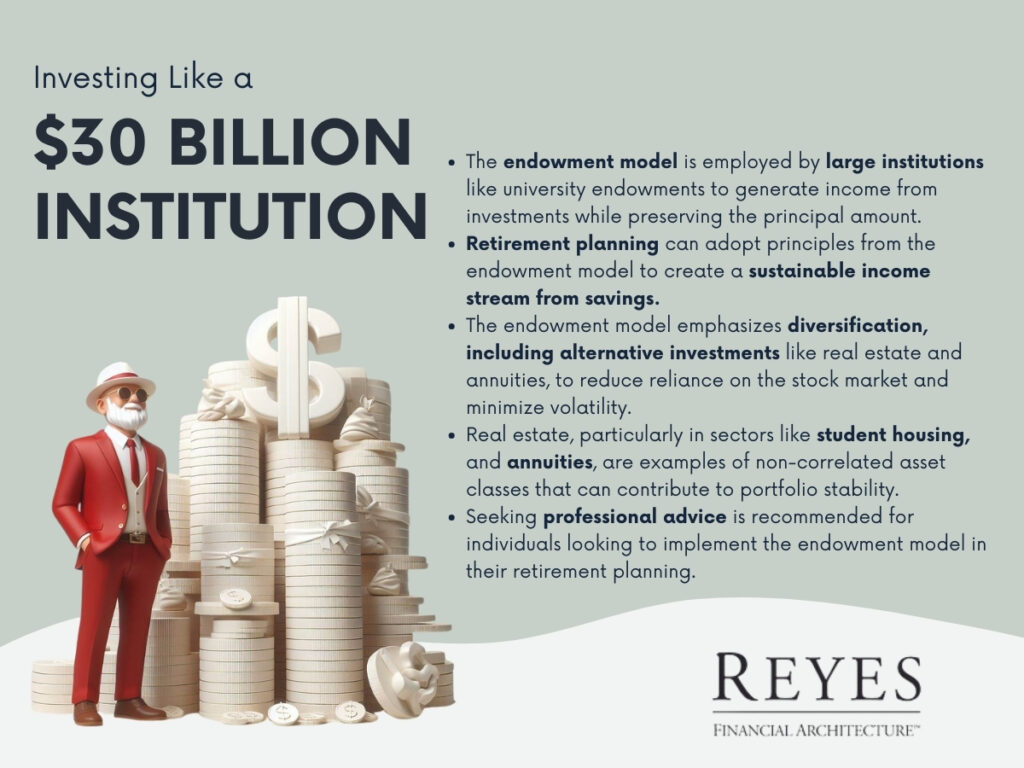
At its core, an endowment is a financial asset, like a fund, held by institutions such as universities. It’s made up of donations that are invested to generate income for the institution. The principal amount generally remains intact while the income supports various expenses.
The Yale endowment, under Swensen's management, became a hallmark of this approach. Yale’s strategy was not just successful but also revolutionary in how it diversified investments beyond the traditional stock and bond portfolio. This diversification aimed to achieve steady returns while minimizing risks.
Retirement planning can be akin to managing an endowment. In both cases, the goal is to create a sustainable income stream from a large pool of savings. The typical recommendation for endowment funds is to aim for a 5% annual distribution. This figure interestingly aligns with the retirement income strategies suggested by many financial planners.
However, a critical difference lies in the investment approach. Traditional retirement portfolios often focus heavily on stocks and bonds. In contrast, the endowment model advocates for a more diversified portfolio including alternative investments.
The endowment model’s success largely stems from its inclusion of alternative investments. These can range from private equity and hard assets like real estate to even more niche options like annuities. For instance, Yale’s portfolio in 2001 included a significant portion in hard assets, primarily real estate, alongside a smaller proportion in domestic and foreign equities.
This diversification strategy not only reduces reliance on the stock market but also potentially smoothens out returns, reducing volatility. The objective is to create a portfolio that can withstand market downturns better and provide more consistent returns over time.
Real estate, especially in sectors like student housing, is a prime example of an alternative investment that can offer stable returns. Properties near major universities, such as USC, Notre Dame, or Northwestern University, can provide a steady income stream, often with tax advantages.
Annuities are another diversifier in this model. While not directly linked to stock or bond markets, they can provide a steady income, adding another layer of stability to a retirement portfolio.
One of the key strengths of the endowment model is its use of non-correlated asset classes. Investments like real estate or annuities don’t necessarily move in tandem with the stock or bond markets. This non-correlation can significantly reduce the portfolio's overall risk.
For individual investors, adopting an endowment-like strategy means moving beyond the conventional wisdom of a stock-and-bond-dominated portfolio. It involves exploring and investing in a variety of asset classes. However, this approach requires careful planning and a thorough understanding of each investment type.
Given the complexity of this investment strategy, seeking professional advice is prudent. Financial advisors with experience in the endowment model can provide valuable insights and help tailor a portfolio that suits an individual’s retirement goals and risk tolerance.
The endowment model, inspired by the strategies of large institutions like Yale University, presents an innovative approach for individual investors, especially those in retirement planning.
Its focus on diversification across various asset classes aims to provide a balanced investment portfolio that can weather market volatility and generate sustainable income. While it may require stepping out of the traditional investment comfort zone, the potential for a more stable and robust retirement income is an enticing prospect for those willing to explore beyond stocks and bonds.
Check out this video to get some insight into David's personal story which lends to the purpose in his passion to help his clients achieve retirement success.
The world of retirement planning is deeply influenced by the personal experiences and histories of those who navigate it. One such journey, devoid of specific names but rich in lessons and insights, offers a valuable perspective on how early life experiences and family histories can shape professional philosophies in financial planning.

The story begins with a young individual, whose life was significantly impacted by their parents' divorce at the age of two. Raised by a single mother with two other children, this person found solace and guidance in the care of their grandparents. These formative years spent with grandparents in a small town provided foundational life lessons and values.
One grandparent, a dedicated employee at a major company like Sears Roebuck, which narrowly escaped bankruptcy, served as an emblem of resilience and adaptability. This grandparent's profession as a television repairman represented a now-obsolete trade, reflecting a bygone era of technological simplicity and hands-on skill.
The grandparent's investment in company stock, such as Sears, showcased the importance of financial involvement and awareness. This early exposure to stock investments and the significance of pension plans left a profound impact on the young individual, instilling a keen interest in financial planning and investment.
Despite modest means, the grandparent exemplified fiscal prudence and the virtue of saving, owning a home outright, and living within one's means. These characteristics were not just survival strategies but were also foundational principles that would later inform a career in financial planning.
A turning point in this narrative was the grandparent's diagnosis with dementia, leading to significant healthcare expenses that eventually depleted their savings. This transition to relying on Medicaid, a program necessitating minimal personal assets, highlighted the financial vulnerabilities faced in old age.
The family's subsequent struggle with a lien on their property due to Medicaid benefits underscored the complexities and challenges of elder care and its financial implications. This experience, occurring at the onset of the individual’s career in financial planning, was a catalyst for a deeper understanding of elder law and financial protection strategies.
These personal experiences with family financial challenges directly influenced the individual's approach to retirement planning. Observing first-hand the impact of medical expenses and the necessity of financial preparedness in later life, the individual adopted a philosophy emphasizing the protection of capital, its growth, and the generation of sustainable income from it.
This approach was further informed by the mindset of the "depression babies" generation, known for their skepticism towards banks and cautious approach to market investments. This background instilled a sensitivity towards clients who value security and stability in their financial planning.
This narrative, while not tied to a specific individual, illustrates how personal experiences can profoundly shape professional approaches in fields like financial planning. It's a poignant reminder that behind the technical aspects of financial advising are human stories, experiences, and histories that influence and guide the strategies and advice offered by professionals in this field.
In recent times, the financial markets have been characterized by significant volatility and unpredictability, often leading investors to experience what is popularly known as the FOMO (Fear of Missing Out) Market. This term aptly encapsulates the anxiety and urgency that investors feel in the face of rapidly changing market conditions, driven by the fear of missing out on potential gains.
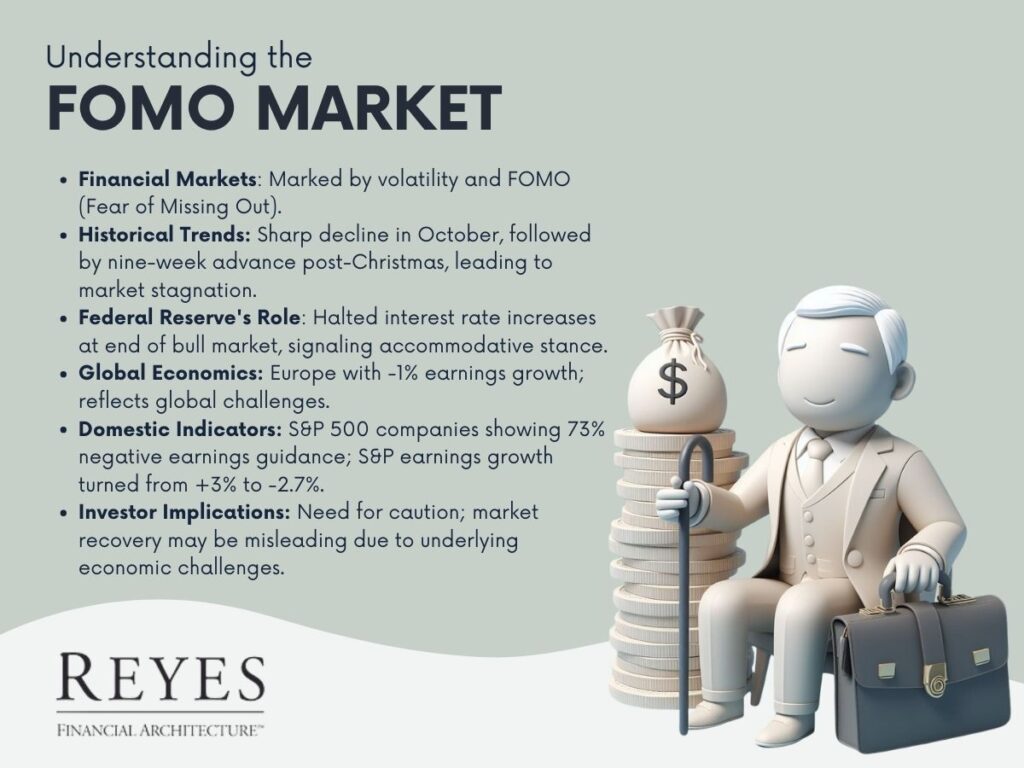
Historically, October of the previous year marked one of the worst performances since 1931, followed by a nine-week continuous advance in the market post-Christmas. This pattern of a sharp decline followed by a rapid ascent has essentially led to a stagnation in market progress over the past year and a half.
The last quarter of the year saw the market in a precarious position, facing challenges from various fronts. However, the Federal Reserve's intervention played a pivotal role in altering this trajectory. The Fed's decision to halt interest rate increases towards the end of a bull market was an unprecedented move, breaking away from traditional monetary policy patterns. This cessation is particularly notable as the market technically entered a bear phase, with a 20% drop from its peak.
The Federal Reserve's actions are crucial in understanding market dynamics. Typically, the Fed raises interest rates to curb inflation and stabilizes the economy, but in this case, they chose a different path. By not increasing rates, the Fed essentially signaled a more accommodative monetary stance, which historically tends to boost market confidence and investment.
Globally, Europe exhibited negative earnings growth in the last year, with a decline of about 1%. This is significant as it reflects broader economic challenges beyond the United States. In the domestic context, nearly all S&P 500 companies have reported their earnings, with a staggering 73% providing negative earnings guidance. This indicates a pessimistic outlook for the future, with expectations of performance being worse than the present.
The S&P earnings growth, which was estimated at 3% in December, has now turned negative, standing at -2.7%. This downturn is particularly stark, considering the record-high earnings growth witnessed in 2018.
These market conditions underscore the need for caution among investors. The rapid recovery of the markets from recent losses might create an illusion of stability and growth. However, the underlying economic indicators suggest otherwise. The volatility is likely to persist, and it's crucial for investors to be prepared for this uncertainty.
Investors are advised to develop a comprehensive understanding of the risks associated with their portfolios. This involves not only a keen awareness of market trends but also a thorough assessment of individual investment objectives, risk tolerance, and long-term financial goals.
In conclusion, navigating the FOMO Market requires a balanced approach, blending caution with opportunity. Understanding the broader economic context, staying informed, and aligning investment strategies with individual risk profiles are key to successfully managing investments in these volatile times. Investors should remain vigilant, adaptable, and informed to make the most out of the opportunities that arise, while safeguarding their investments against potential downturns
Retirement planning is an essential aspect of financial management, yet it remains a challenging endeavor for many. Understanding the nuances of investment, market trends, and effective strategies is vital for a secure retirement.
This blog post explores key principles and strategies to help individuals build a robust retirement plan, emphasizing risk management and financial efficiency.
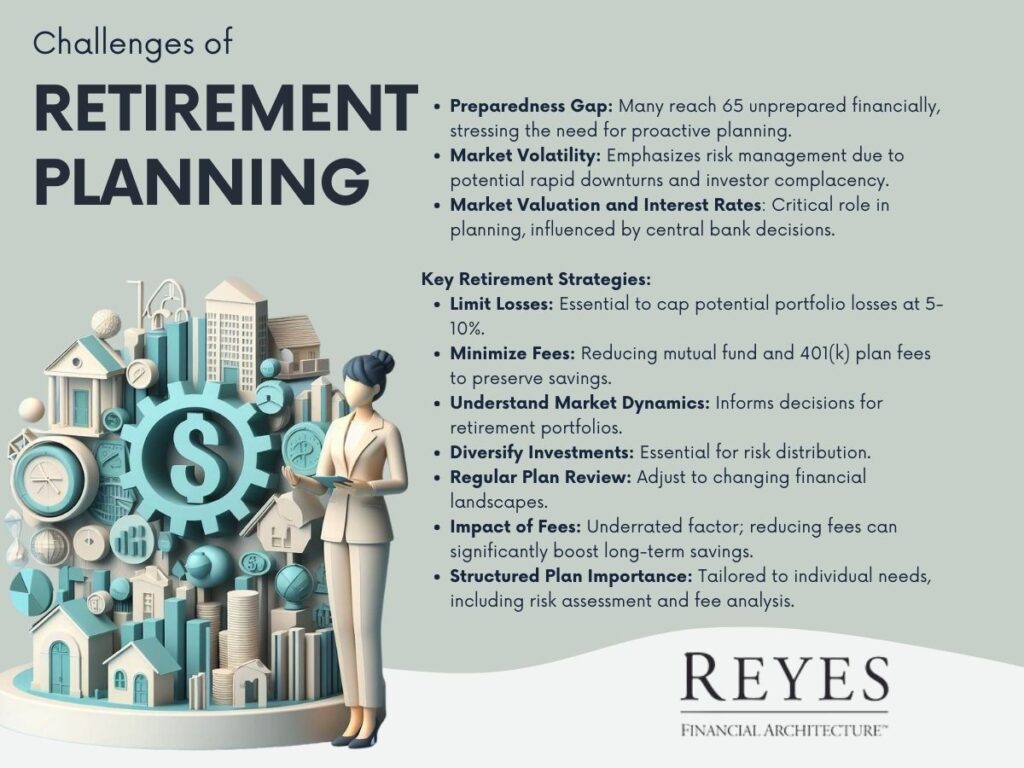
Statistics indicate a concerning trend: a large percentage of individuals reach the age of 65 without adequate financial resources, often relying on family or government support. This underscores the importance of proactive and strategic retirement planning, focusing on creating a guaranteed lifetime income.
Market volatility is a significant factor in retirement planning. Historical trends show substantial market downturns can occur rapidly, highlighting the need for a risk-aware investment approach. As time passes since major financial crises, there's a risk of investor complacency. Acknowledging and planning for potential market fluctuations is crucial in safeguarding retirement funds.
The valuation of the market, often influenced by decisions made by central banks like the Federal Reserve, especially regarding interest rates, plays a critical role in retirement planning. Overvaluation of the market and fluctuating earnings projections can impact investment strategies. Recognizing these factors can aid in making informed decisions for retirement portfolios.
To achieve a secure retirement, certain strategies and principles should be considered:
Additional strategies include understanding market dynamics, diversifying investments, and regularly reviewing and adjusting financial plans.
One often overlooked aspect of retirement planning is the impact of fees on long-term savings. Many individuals are unaware of the fees they incur, especially in investment products like mutual funds and employer-sponsored plans such as 401(k)s. Reducing these fees can lead to significant savings over time.
A structured retirement plan is critical. It should include a thorough risk assessment, an analysis of fees, and a comprehensive strategy tailored to individual needs and goals. A well-constructed plan provides clarity and a roadmap for achieving retirement objectives.
Effective retirement planning requires a multifaceted approach, balancing risk management, financial efficiency, and a deep understanding of market conditions. By adopting key strategies and maintaining a focus on long-term goals, individuals can enhance their chances of a financially secure retirement.
The process involves regular review and adaptation to changing circumstances, ensuring that retirement funds are not only accumulated but also protected and optimized for the long haul.
https://youtu.be/tYioyLxbNTI
Take a minute to watch this video for important information on long-term care, a topic everyone needs to be ahead of.
Long-term care (LTC) is a critical aspect of health and personal care that affects a significant portion of the population. Statistics indicate a high probability—around 70%—that an individual or their spouse will require long-term care at some point. This statistic underscores the importance of understanding what long-term care entails, its costs, and how to prepare for it.

Long-term care refers to a variety of services and supports tailored to meet an individual’s personal care needs over an extended period. Contrary to common misconceptions, most long-term care is not medical in nature. Instead, it predominantly involves assistance with everyday activities crucial for daily living.
Activities of Daily Living, or ADLs, are fundamental tasks that most people perform daily without assistance. These include:
Instrumental Activities of Daily Living, or IADLs, are tasks that are somewhat more complex than ADLs and are essential for independent living. These include:
The cost of long-term care can vary significantly based on several factors:
The initial premium level for long-term care insurance tends to increase with the age of the applicant. Younger individuals typically face lower premiums, highlighting the advantage of planning for long-term care early.
Qualifying for long-term care insurance becomes more challenging with age. Statistics show that 1 in 4 applicants between the ages of 60 and 69 do not qualify for such insurance. This statistic is a stark reminder of the importance of early planning.
Given the high likelihood of needing long-term care and the associated challenges and costs, it is crucial to understand the options and prepare adequately. This preparation is not just a personal matter but also a significant consideration for families.
Understanding and preparing for long-term care is a critical aspect of life planning. Given the high probability of needing such care, it’s prudent to start planning early. This includes understanding what long-term care entails, evaluating insurance options, and considering personal and family needs. By taking proactive steps today, individuals can ensure they have the support and resources they need to maintain their quality of life and independence in the future.
In today's rapidly evolving financial landscape, it's crucial to stay informed and vigilant about the state of the markets. Recently, an expert provided valuable insights on the current state of the market, emphasizing the unprecedented volatility that has gripped the financial world. In this article, we will delve into the reasons behind this cautionary stance and explore the factors contributing to the current market turmoil.
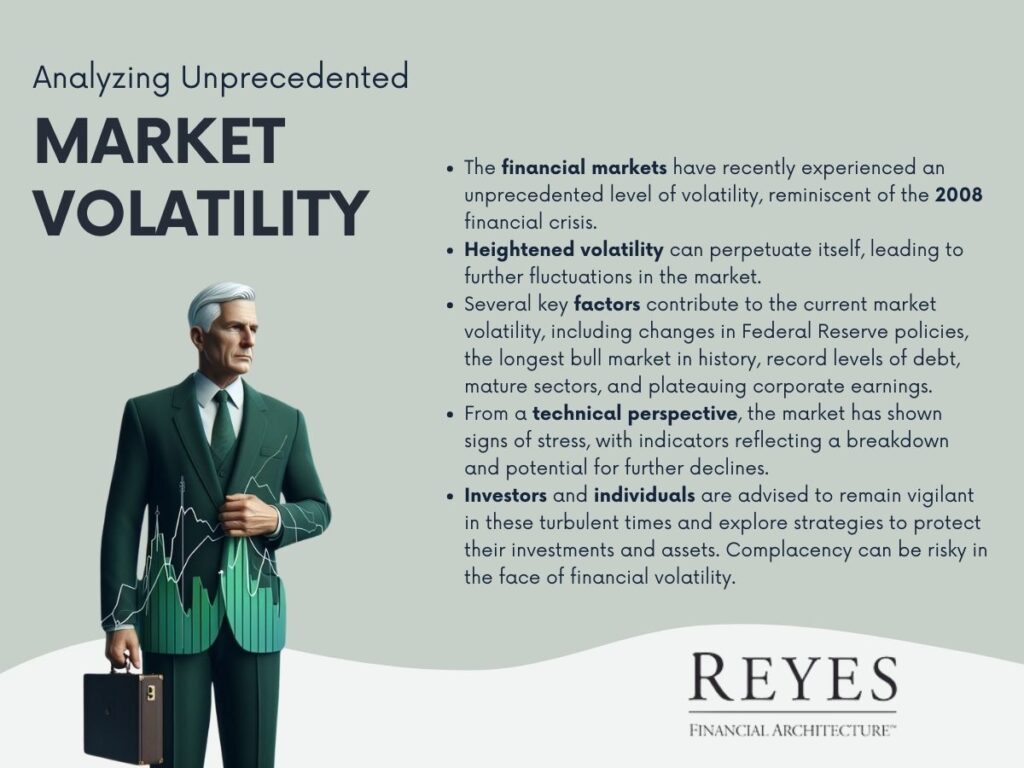
As noted, the financial markets have experienced an unusually high level of volatility in recent times, reminiscent of the tumultuous days of the 2008 financial crisis. This heightened level of market turbulence has not been witnessed since October 2008 and even 2010 came close to matching the current instability.
The adage that "volatility begets volatility" holds true in the financial world. When the market experiences significant fluctuations, it tends to perpetuate this trend. Over the last decade, investors grew accustomed to relative stability, which may have bred complacency. However, the current situation signals a shift in the market dynamics.
Several factors contribute to the heightened volatility observed in today's market:
From a technical perspective, the market has shown signs of stress not seen since 2008 and 2011, with indicators reflecting a breakdown. The S&P 500 is currently hovering around the 2600 level, reflecting a 10% drop from its peak. If the market breaks through this level, it could potentially decline to around 2,300, marking a 20% decline.
In conclusion, the recent market turbulence serves as a stark reminder that complacency in the face of financial volatility can be perilous. The combination of factors such as shifting Federal Reserve policies, an extended bull market, mounting debt levels, and plateauing corporate earnings has created a climate of uncertainty in the financial markets.
Investors and individuals alike would be wise to remain vigilant in these turbulent times. As market experts aptly put it, it's not the time to be complacent. Exploring strategies to protect investments and assets during these uncertain times may prove to be a prudent course of action.
In this article, we will explore the dynamics of the stock market and provide insights into its recent performance, potential risks, and important considerations for investors. While we often focus on various aspects of financial planning, it's crucial to address the current state of the market, especially given the unprecedented bull run we've witnessed over the past decade.
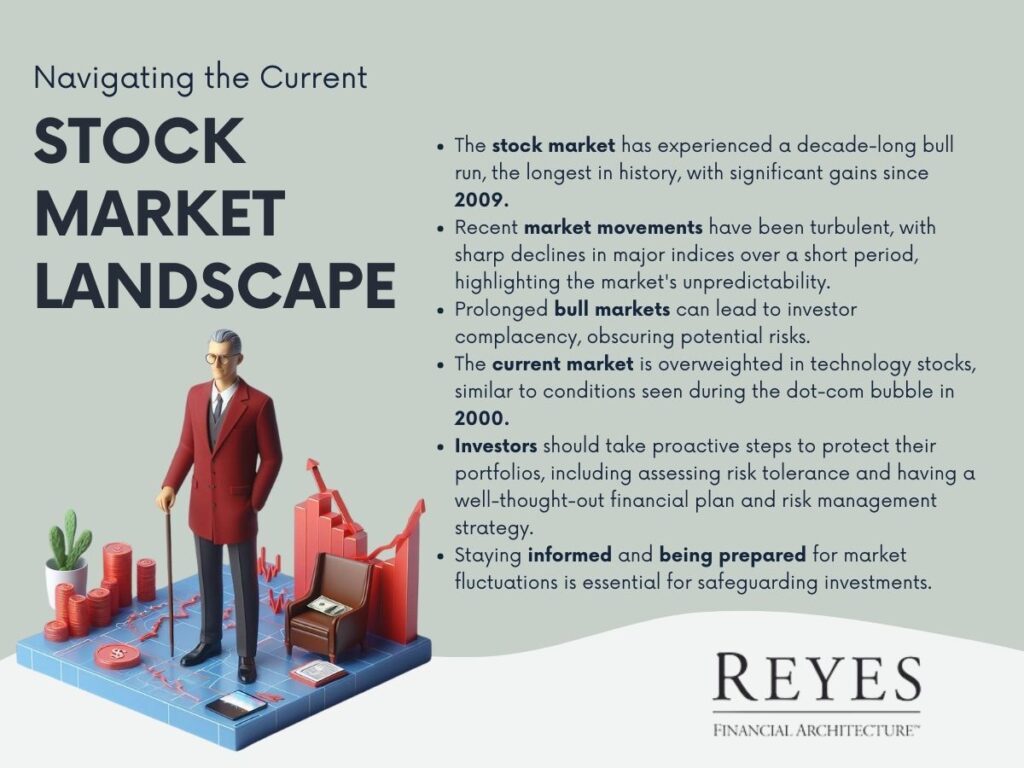
The stock market has experienced an exceptional 10-year bull run, marking its longest duration in history. Since 2009, the market has surged by more than 330%. To put it into perspective, if we were to compare this to a baseball game, we would be in extra innings.
However, the prolonged period of growth raises concerns and highlights the importance of being prepared for potential challenges ahead.
Recent market movements have been quite turbulent. For instance, in just three days in October, the Dow Jones Industrial Average experienced a sharp decline of 1,500 points, resulting in a 7% loss. The S&P 500, which had been up 9% year-to-date, saw its gains dwindle to nearly flat at just 1%. The Nasdaq also faced a 9% drop, with major tech companies like Netflix and Amazon witnessing substantial declines of 15% and 13%, respectively. These significant fluctuations occurred within a single week, emphasizing the market's unpredictability.
One of the primary concerns during a prolonged bull market is investor complacency. The more the market thrives, the more complacent investors tend to become. This complacency can be dangerous because it often obscures the potential risks that lie ahead.
As the famous adage by Warren Buffett goes, "When others are fearful, be greedy, and when others are greedy, be fearful." Currently, there seems to be a general eagerness to invest in the stock market, particularly in the tech sector.
The S&P 500 is currently overweighted by approximately 30% in technology stocks. This means that a significant portion of the S&P 500's value is attributed to technology companies. This level of overweighting in technology reminds us of the dot-com bubble in 2000, which led to an 80% decline in tech stocks.
Similarly, during the financial crisis, the S&P 500 had about 25% of its value tied to financial stocks, which subsequently lost 80%. The current overvaluation in technology stocks should not be underestimated.
Given the current market conditions and the looming risk of a downturn, it is crucial for investors to take proactive steps to protect their portfolios. While the idea of a bear market may seem alarming, it's essential to be prepared for potential losses ranging from 30% to even 50-60%. Being proactive and adequately prepared is the key to safeguarding your investments in such scenarios.
In conclusion, it is vital for investors to stay informed, assess their risk tolerance, and be ready to adapt their investment strategies in response to changing market conditions. Regardless of market circumstances, it is prudent to have a well-thought-out financial plan and risk management strategy in place. Your financial well-being is of paramount importance, and being prepared for market fluctuations is a responsible approach to safeguarding your investments.
Click the video above to follow along as David Reyes, The Retirement Architect provides insightful information on Annuities
In today's ever-changing financial landscape, planning for retirement has never been more critical, especially as we live longer lives than previous generations. The need for a guaranteed lifetime income has become paramount. In this article, we will delve into the world of annuities and their role in securing your financial future.
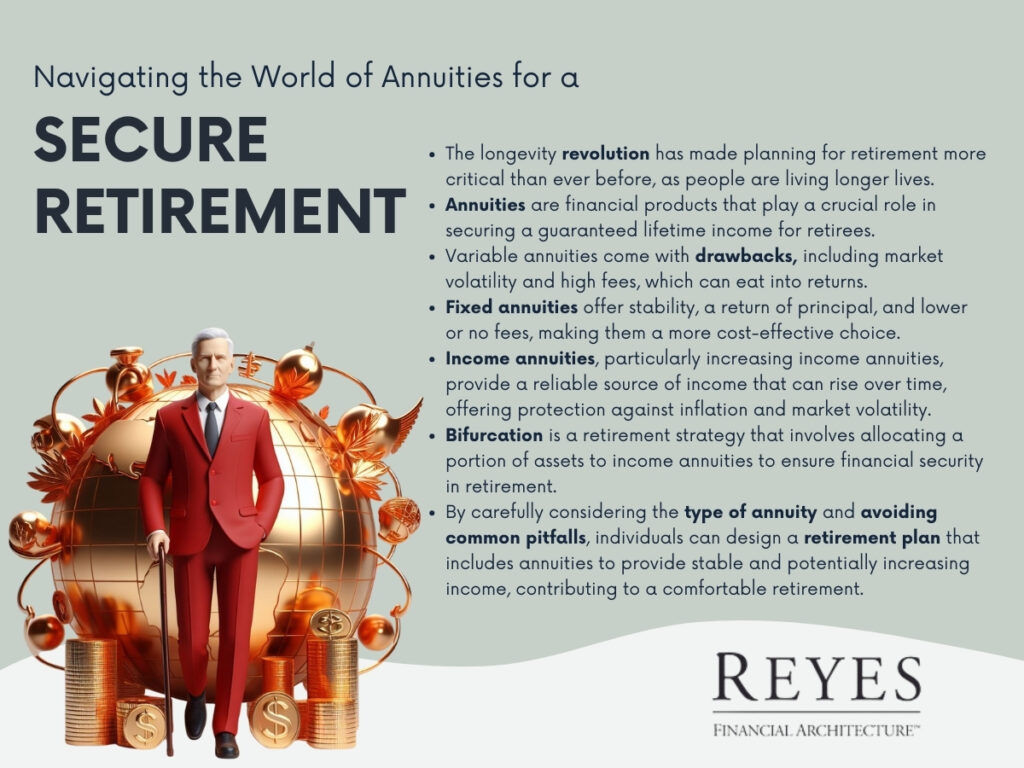
The 21st century has brought about a remarkable revolution – the longevity revolution. On average, people today live 34 years longer than their great-grandparents, leading to a second lifetime, complete with unique financial challenges and opportunities.
Annuities have garnered both praise and criticism in the financial world. To better comprehend this topic, let's explore the various aspects of annuities.
Annuities come with their share of drawbacks. Variable annuities, as the name implies, can be quite volatile, leading to uncertainty for investors. One of their major downsides is the high fees, which can amount to as much as three or four percent annually. To put it in perspective, a $500,000 annuity could accrue $20,000 in annual fees alone, necessitating a 4% return just to break even.
To avoid these pitfalls, many investors opt to replace variable annuities with fixed annuities. Fixed annuities offer stability and peace of mind, guaranteeing the return of your principal and shielding your capital from market volatility. The key distinction is that fixed annuities come with lower or even zero fees, offering significant cost savings over time.
Now, let's focus on the positive side of annuities. Given the longevity revolution, the most significant concern for retirees is outlasting their income. This fear is justified, especially for those relying on assets like stocks and bonds, which can be vulnerable to market fluctuations, significantly impacting retirement income.
To mitigate this risk, retirees often employ a strategy called bifurcation. This approach involves dividing assets into two categories: one designated for growth and the other for income. By allocating a portion of assets to income, typically around 30% to 60%, retirees can ensure a steady stream of funds to cover essential expenses, providing financial security in retirement.
Fixed income annuities play a crucial role in this strategy, offering guaranteed lifetime income—a lifeline in retirement planning. Traditional annuities provide level payouts throughout their lifetime, but there's a variant: increasing income annuities. These annuities offer both guaranteed lifetime income and the potential for rising payments over time.
Consider a scenario where you retire at 65 and secure a guaranteed lifetime income of $69,495 annually from a $1 million annuity. After a decade, your income from the same annuity has increased to $90,000 annually—a remarkable 25% growth. Increasing income annuities serve as a robust defense against inflation, healthcare costs, and market volatility, providing peace of mind during retirement.
As we navigate the longevity revolution, securing a stable and potentially increasing income in retirement becomes crucial. Annuities, when chosen wisely, can be a valuable addition to your retirement portfolio. By steering clear of the pitfalls associated with variable annuities and embracing the benefits of fixed and increasing income annuities, you can design a secure retirement plan. It is essential to plan diligently, stay informed, and consider the role annuities can play in your financial future as you prepare for a comfortable retirement.